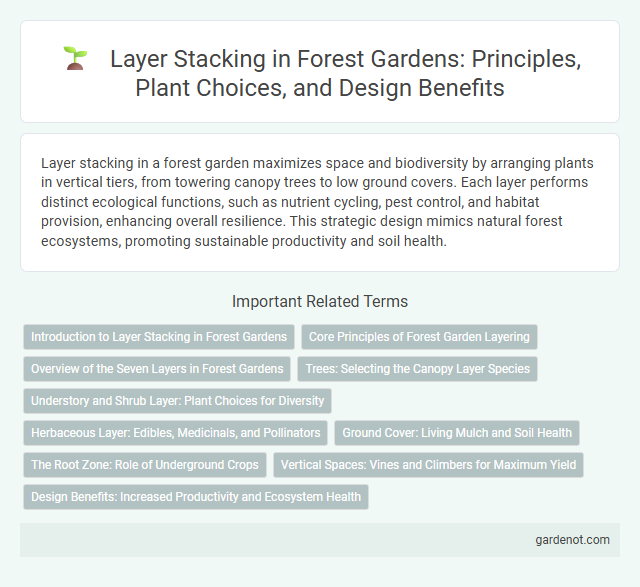Layer stacking in a forest garden maximizes space and biodiversity by arranging plants in vertical tiers, from towering canopy trees to low ground covers. Each layer performs distinct ecological functions, such as nutrient cycling, pest control, and habitat provision, enhancing overall resilience. This strategic design mimics natural forest ecosystems, promoting sustainable productivity and soil health.
Introduction to Layer Stacking in Forest Gardens
Layer stacking in forest gardens involves organizing plants vertically within different layers such as canopy, understory, shrub, herbaceous, ground cover, root, and vertical layers. This method maximizes space, enhances biodiversity, and improves overall ecosystem resilience by mimicking natural forest structures. Effective layer stacking optimizes sunlight capture, soil health, and nutrient cycling, promoting sustainable and productive garden systems.
Core Principles of Forest Garden Layering
Forest garden layer stacking involves arranging plant species in distinct vertical layers to maximize space, biodiversity, and resource efficiency. The core principles of forest garden layering emphasize planting tall canopy trees, mid-story shrubs, ground covers, root crops, and climbers in harmonious association to mimic natural ecosystems. This stratification enhances photosynthesis, nutrient cycling, and habitat diversity, promoting sustainable and resilient food production.
Overview of the Seven Layers in Forest Gardens
Seven layers in forest gardens comprise canopy, low tree, shrub, herbaceous, ground cover, root, and vertical layers, each playing a vital role in maximizing space and biodiversity. Canopy trees provide shade and structure, while low trees fill mid-level gaps for fruit production and habitat. Shrubs and herbs offer diverse yields and pest control, ground covers prevent soil erosion, root layers enhance nutrient cycling, and vertical layers support climbing plants, creating a highly productive, sustainable ecosystem.
Trees: Selecting the Canopy Layer Species
Choosing canopy layer species in a forest garden involves selecting tall, fast-growing trees that provide shade, improve soil fertility, and support biodiversity. Ideal species include nitrogen-fixing trees like black locust (Robinia pseudoacacia) and fruit trees such as apple (Malus domestica) or walnut (Juglans regia), which create a microclimate beneficial for understory plants. Proper layer stacking enhances ecosystem productivity by balancing light capture, nutrient cycling, and habitat complexity.
Understory and Shrub Layer: Plant Choices for Diversity
The understory and shrub layers in a forest garden are crucial for enhancing biodiversity and ecosystem resilience, with plants like hazelnut, elderberry, and serviceberry providing food and shelter for wildlife while improving soil health. Selecting diverse species such as currants, gooseberries, and shade-tolerant herbs like wood sorrel promotes layered growth and nutrient cycling. Integrating nitrogen-fixing shrubs like sea buckthorn supports adjacent trees and fosters a balanced, productive environment within the garden's mid-canopy zone.
Herbaceous Layer: Edibles, Medicinals, and Pollinators
The Herbaceous Layer in a forest garden includes edible plants like culinary herbs and leafy greens, medicinal species such as echinacea and chamomile, and pollinator-friendly flowers like lavender and borage. This layer maximizes biodiversity by attracting beneficial insects, improving soil health, and providing continuous harvests throughout the growing season. Integrating diverse herbaceous plants supports ecosystem resilience and enhances overall productivity in permaculture design.
Ground Cover: Living Mulch and Soil Health
Ground cover plants in forest gardens function as living mulch that protect soil from erosion while enhancing moisture retention and suppressing weeds. Species such as clover, creeping thyme, and vetch contribute to nitrogen fixation, improving overall soil fertility and promoting microbial activity. These living mulches create a dynamic soil environment essential for nutrient cycling and long-term garden productivity.
The Root Zone: Role of Underground Crops
The root zone in a forest garden plays a crucial role in nutrient cycling and soil health through underground crops like root vegetables and nitrogen-fixing plants. These subterranean layers improve soil structure, enhance water retention, and promote beneficial microbial activity. Root crops such as carrots, beets, and garlic contribute to diverse biomass underground while supporting above-ground layers in a sustainable ecosystem.
Vertical Spaces: Vines and Climbers for Maximum Yield
Utilizing vertical spaces with vines and climbers significantly enhances forest garden productivity by maximizing light exposure and spatial efficiency. Species like grapes, kiwis, and passionfruit thrive on trellises or natural supports, creating multiple harvest layers within a single footprint. Integrating these vertical plants not only increases yield but also supports biodiversity and microhabitats in the garden ecosystem.
Design Benefits: Increased Productivity and Ecosystem Health
Layer stacking in forest garden design maximizes vertical space by integrating multiple plant layers, from canopy trees to ground cover, enhancing overall productivity and biodiversity. This approach creates diverse habitats that support beneficial insects and wildlife, contributing to the ecosystem's resilience and health. Efficient use of sunlight, nutrients, and water through layered planting results in higher yields and sustainable nutrient cycling.
Layer stacking Infographic

 gardenot.com
gardenot.com